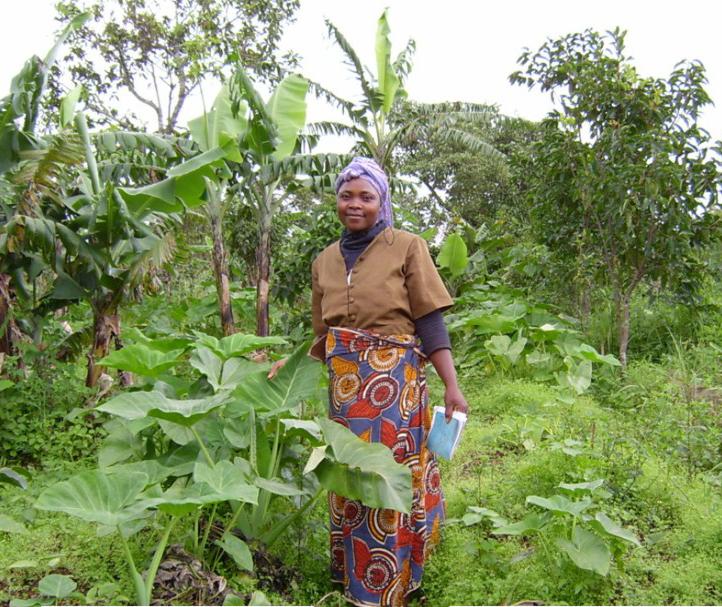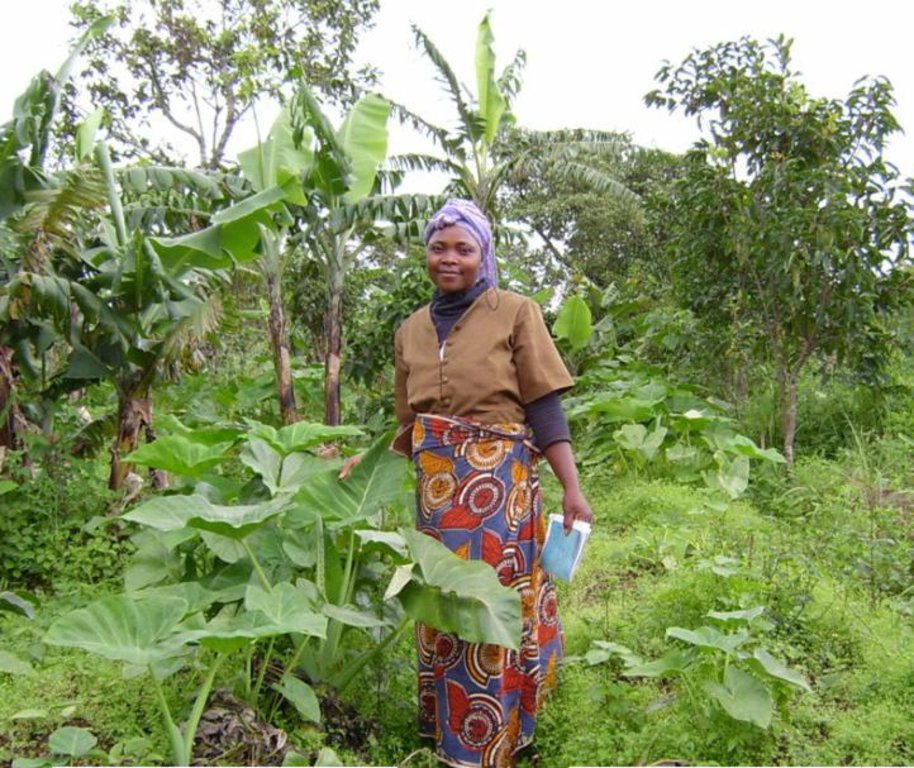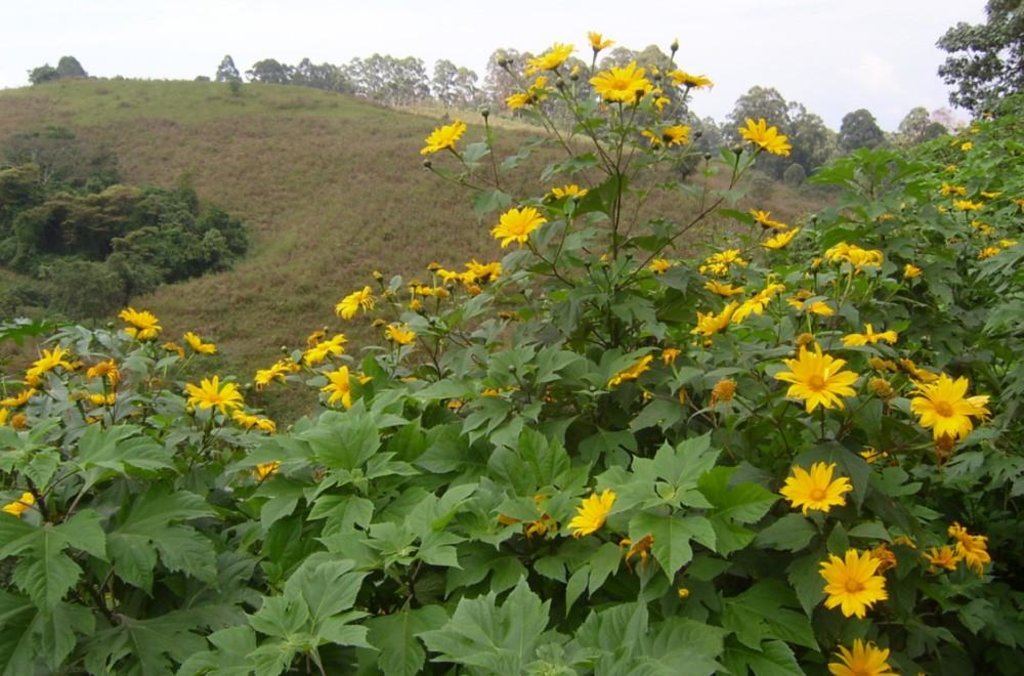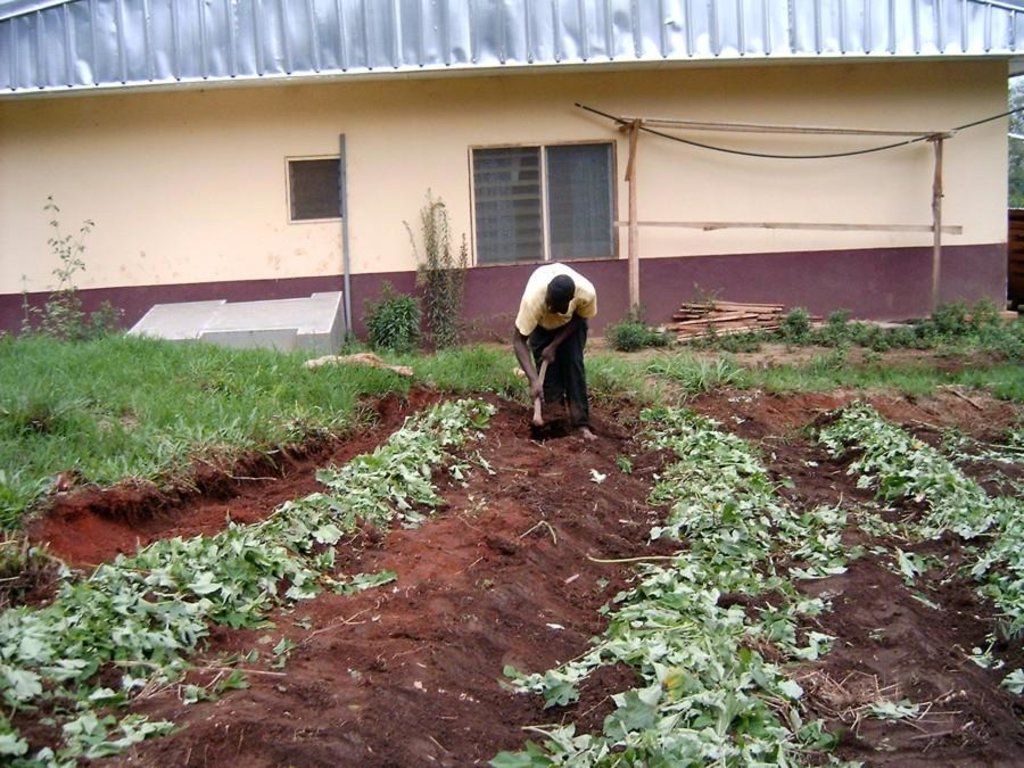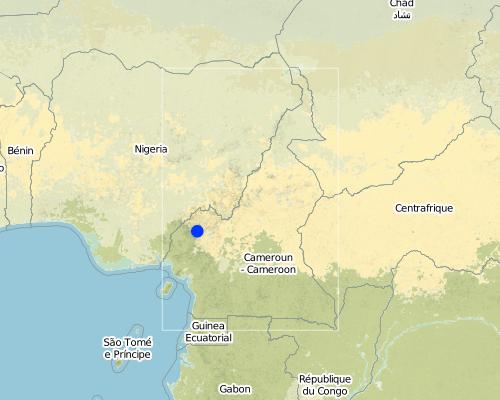Green manuring with Tithonia [Cameroon]
- Creation:
- Update:
- Compiler: Unknown User
- Editor: –
- Reviewer: Alexandra Gavilano
Tithonia diversifolia (Mexican sunflower)
technologies_948 - Cameroon
View sections
Expand all Collapse all1. General information
1.3 Conditions regarding the use of data documented through WOCAT
When were the data compiled (in the field)?
01/12/2004
The compiler and key resource person(s) accept the conditions regarding the use of data documented through WOCAT:
Yes
2. Description of the SLM Technology
2.1 Short description of the Technology
Definition of the Technology:
Application of Tithonia diversifolia (Mexican sunflower) as green manure
2.2 Detailed description of the Technology
Description:
Tithonia diversifolia hedges grow along roadsides or farm boundaries. The green leaf biomass is very suitable as green manure for annual crops, since the plant has a high content of nitrogen and phosphurus, and decomposes quickly after application to the soil: its nutrients are released within one growing season.
Purpose of the Technology: Tithonia biomass enhances soil organic matter and soil fertility, resulting in higher crop yields. The treatment supplies the crop with nutrients at the early stage of the growing process, and thus improves the establishment of the crops through the early development of a good rooting system. The technology is especially beneficial for maize: yields in the study area increased by over 50%.
Establishment / maintenance activities and inputs: At an early stage of plant growth, fresh green leaves and stems are cut, chopped and applied on the cropland as green manure after the first pass of ridging. The fresh material is spread over the half-made ridges at a ate of 2 kg per m2 and then covered with about 5-10 cm of soil to finish the ridges. Sowing of crop seeds is done only after a week or more, because of heat generation during the decomposition process of the leaves (which could damage the seeds).
Natural / human environment: Tithonia can also be applied as mulch 6 to 8 weeks after planting the crop. Covering the mulch with a little soil facilitates nutrient release. Tithonia green manuring - before planting - and mulching can be combined, which is especially applicable to maize, beans and cabbage cultivation. Tithonia hedgerows have to be cut back regularly; otherwise it can spread fast and become a weed. Interplanting Tithonia in the field is not recommended due to root competition with crops.
2.3 Photos of the Technology
2.5 Country/ region/ locations where the Technology has been applied and which are covered by this assessment
Country:
Cameroon
Region/ State/ Province:
Akiri
Further specification of location:
North-West Province
Map
×2.6 Date of implementation
If precise year is not known, indicate approximate date:
- less than 10 years ago (recently)
2.7 Introduction of the Technology
Specify how the Technology was introduced:
- through projects/ external interventions
Comments (type of project, etc.):
Tithonia was used in Kenya as green manure. In 1997 a PRTC/Forta/SCA joint research team started to try it in the North-West Province of Cameroon too.
3. Classification of the SLM Technology
3.2 Current land use type(s) where the Technology is applied

Cropland
- Annual cropping
Comments:
Major land use problems (compiler’s opinion): Soil fertility decline and reduced organic matter content.
Major land use problems (land users’ perception): Soil fertility decline
Type of cropping system and major crops comments: very heterogeneous sometimes.
E.g.: Maize/Beans/Yams: Planted in March, harvest in September (Maize), August (Beans), january of the following year (Yams)
3.3 Further information about land use
Comments:
Water supply: rainfed, mixed rainfed - irrigated
Number of growing seasons per year:
- 1
Specify:
Longest growing period in days: 200
Longest growing period from month to month: March - Mid-October
3.5 Spread of the Technology
Comments:
Total area covered by the SLM Technology is 0.3 m2.
Another 9 sites in the North-West Province of Cameroon are places where the SWC technology Tithonia diversifolia as green manure was applied
3.6 SLM measures comprising the Technology

agronomic measures
- A2: Organic matter/ soil fertility
Comments:
Main measures: agronomic measures
Type of agronomic measures: mulching, green manure
3.7 Main types of land degradation addressed by the Technology

chemical soil deterioration
- Cn: fertility decline and reduced organic matter content (not caused by erosion)
Comments:
Main type of degradation addressed: Cn: fertility decline and reduced organic matter content
3.8 Prevention, reduction, or restoration of land degradation
Specify the goal of the Technology with regard to land degradation:
- reduce land degradation
- prevent land degradation
Comments:
Main goals: prevention of land degradation, mitigation / reduction of land degradation
4. Technical specifications, implementation activities, inputs, and costs
4.2 Technical specifications/ explanations of technical drawing
Green manuring with Tithonia: application good on maize, beans, soybeans, yam, cocoyam, etc.
Technical knowledge required for field staff / advisors: moderate
Technical knowledge required for land users: moderate
Main technical functions: increase in soil fertility
Secondary technical functions: increase in organic matter, if planted as living fence prevention of damage by predators
Mulching
Material/ species: Tithonia diversifolia
Green manure
Material/ species: Tithonia diversifolia
4.3 General information regarding the calculation of inputs and costs
other/ national currency (specify):
CFA
Indicate average wage cost of hired labour per day:
3.00
4.6 Maintenance/ recurrent activities
| Activity | Type of measure | Timing/ frequency | |
|---|---|---|---|
| 1. | Cutting back Tithonia hedge | Agronomic | annual |
| 2. | Cutting back Tithonia hedge | Agronomic | annual |
| 3. | Cutting back Tithonia hedge | Agronomic | annual |
| 4. | Cutting back Tithonia hedge | Agronomic | |
| 5. | Laisser l’engrais vert se décomposer au moins une semaine avant de semer la culture | Agronomic |
4.7 Costs and inputs needed for maintenance/ recurrent activities (per year)
Comments:
Machinery/ tools: cutlass, hoe
4.8 Most important factors affecting the costs
Describe the most determinate factors affecting the costs:
Labour costs are the main factor affecting the costs. Labour inputs depend a lot on transport distance between Tithonia hedge and cropland.
5. Natural and human environment
5.1 Climate
Annual rainfall
- < 250 mm
- 251-500 mm
- 501-750 mm
- 751-1,000 mm
- 1,001-1,500 mm
- 1,501-2,000 mm
- 2,001-3,000 mm
- 3,001-4,000 mm
- > 4,000 mm
Agro-climatic zone
- humid
Thermal climate class: subtropics
5.2 Topography
Slopes on average:
- flat (0-2%)
- gentle (3-5%)
- moderate (6-10%)
- rolling (11-15%)
- hilly (16-30%)
- steep (31-60%)
- very steep (>60%)
Landforms:
- plateau/plains
- ridges
- mountain slopes
- hill slopes
- footslopes
- valley floors
Altitudinal zone:
- 0-100 m a.s.l.
- 101-500 m a.s.l.
- 501-1,000 m a.s.l.
- 1,001-1,500 m a.s.l.
- 1,501-2,000 m a.s.l.
- 2,001-2,500 m a.s.l.
- 2,501-3,000 m a.s.l.
- 3,001-4,000 m a.s.l.
- > 4,000 m a.s.l.
5.3 Soils
Soil depth on average:
- very shallow (0-20 cm)
- shallow (21-50 cm)
- moderately deep (51-80 cm)
- deep (81-120 cm)
- very deep (> 120 cm)
Soil texture (topsoil):
- medium (loamy, silty)
Topsoil organic matter:
- medium (1-3%)
5.6 Characteristics of land users applying the Technology
Market orientation of production system:
- mixed (subsistence/ commercial
- subsistence (self-supply)
Off-farm income:
- less than 10% of all income
Relative level of wealth:
- poor
Individuals or groups:
- individual/ household
Level of mechanization:
- manual work
Indicate other relevant characteristics of the land users:
Land users applying the Technology are mainly disadvantaged land users
Population density: 50-100 persons/km2
Annual population growth: 2% - 3%
Off-farm income specification: No big difference. Almost all farmers live of their own farm production/depend on it.
5.7 Average area of land owned or leased by land users applying the Technology
- < 0.5 ha
- 0.5-1 ha
- 1-2 ha
- 2-5 ha
- 5-15 ha
- 15-50 ha
- 50-100 ha
- 100-500 ha
- 500-1,000 ha
- 1,000-10,000 ha
- > 10,000 ha
Is this considered small-, medium- or large-scale (referring to local context)?
- small-scale
5.8 Land ownership, land use rights, and water use rights
Land ownership:
- individual, not titled
Land use rights:
- individual
6. Impacts and concluding statements
6.1 On-site impacts the Technology has shown
Socio-economic impacts
Production
crop production
production area
Income and costs
farm income
Socio-cultural impacts
health situation
Ecological impacts
Soil
soil moisture
soil cover
Climate and disaster risk reduction
wind velocity
6.2 Off-site impacts the Technology has shown
reliable and stable stream flows in dry season
downstream siltation
groundwater/ river pollution
wind transported sediments
6.4 Cost-benefit analysis
How do the benefits compare with the maintenance/ recurrent costs (from land users' perspective)?
Short-term returns:
positive
Long-term returns:
positive
Comments:
The closer to the field Tithonia is planted, the better is the benefit-cost ratio.
6.5 Adoption of the Technology
Comments:
100% of land user families have adopted the Technology without any external material support
15 land user families have adopted the Technology without any external material support
There is a strong trend towards spontaneous adoption of the Technology
Comments on adoption trend: In the villages where the OFT had been established the interest of other farmers is big.
6.7 Strengths/ advantages/ opportunities of the Technology
| Strengths/ advantages/ opportunities in the land user’s view |
|---|
| is free of charge |
| is a good fertilizer |
| improves yield fast |
| Strengths/ advantages/ opportunities in the compiler’s or other key resource person’s view |
|---|
|
grows in many places How can they be sustained / enhanced? plant Tirhonia around the field, on land that is less suitable for crops |
|
is (so far) for free How can they be sustained / enhanced? cheap manure |
|
increases yields significantly How can they be sustained / enhanced? make sure that it would not get into the field -> manage well |
6.8 Weaknesses/ disadvantages/ risks of the Technology and ways of overcoming them
| Weaknesses/ disadvantages/ risks in the land user’s view | How can they be overcome? |
|---|---|
| Peu devenir envahissante dans les cultures (si plantée trop près) et aussi ailleurs ; certains fermiers considèrent la plante comme toxique | importance du service de conseils, bien informer sur le bonne gestion de Tithonia ; taille régulière |
| Technologie exigeante en main-d’œuvre (récolte, transport, taille régulière, hachage et épandage) | fournir / subventionner des équipements : brouettes pour un transport plus efficace et rapide |
| Peut entraîner des conflits si trop de fermiers veulent l’utiliser | clarifier les droits des usagers ; replanter Tithonia et créer de nouvelles haies |
| Weaknesses/ disadvantages/ risks in the compiler’s or other key resource person’s view | How can they be overcome? |
|---|---|
| can spread as a weed on cropland (if planted close to the fields) and also outside the area where it is used; some farmers consider the plant as poisonous | advisory service is important, good information on proper management of Tithonia; regular cutting |
| Labour-intensive technology (harvest, transport, regular cutting, chopping and spreading) | providing/subsidising transport equipment such as wheelbarrows would make transport more effective and time-saving. |
| might lead to conflicts if too many farmers want to use it | clarify user rights; replant Tithonia plants and grow new hedges. |
Links and modules
Expand all Collapse allLinks
No links
Modules
No modules


